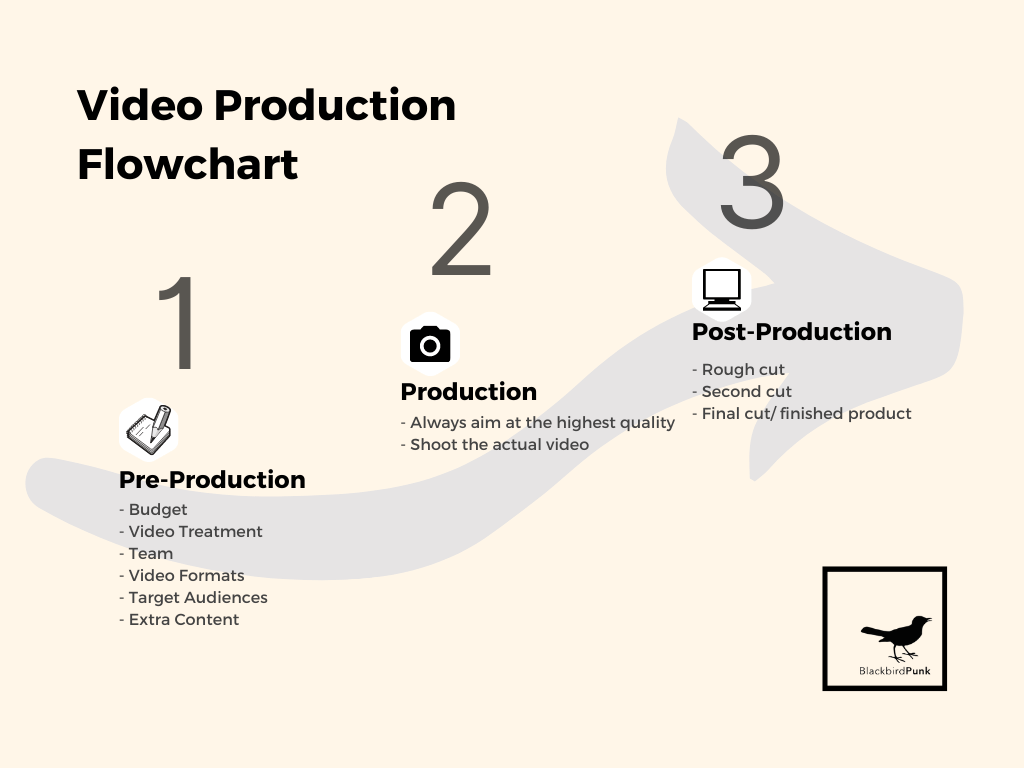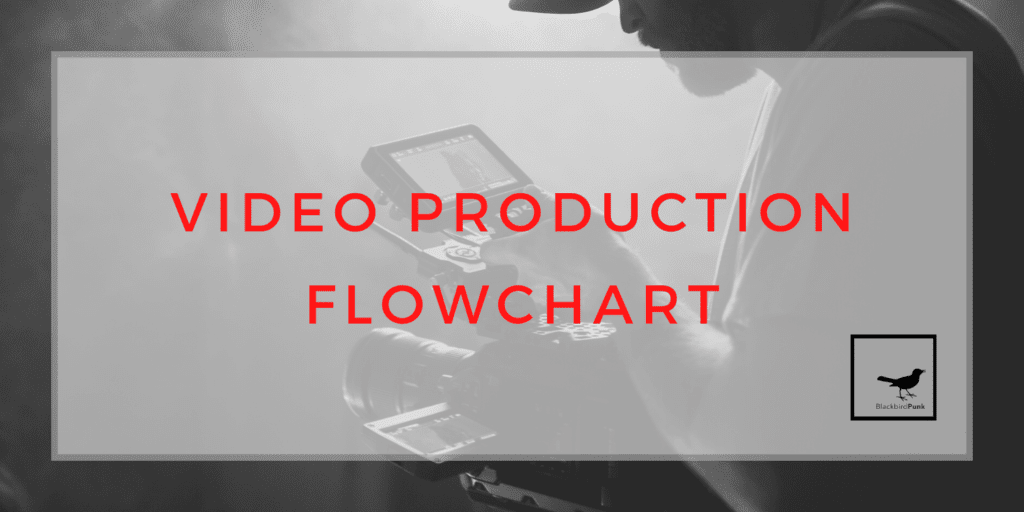Video production flowchart is an all-important tool for anyone in the music industry. No matter if you are a musician and in the business of DIY music videos. Likewise, if you work in a record label, having some knowledge about a Video Production Flowchart can really save your budget. Wondering why?
Keep on reading because in this blogpost I’ll explain to you step by step the reason why you need a video production flowchart and how you create one yourself.
What is a video production flowchart and why you need one?
To put it simply, a video production flowchart is a graphic outline of all the steps needed for creating a high-quality video. Regardless of whether you want to create an official music video, a lyric video, or a behind-the-scenes video, for example.
The idea is that you integrate all the steps necessary. Right from the start of coming up with the idea for the video to the upload onto YouTube.
Creating a video is rarely works for one person alone. Most of the time it’s a group of specialists that work collaboratively on it together. From the camera person to the video editor.
Here’s the thing: being able to clearly communicate your artistic vision with your team is key for reaching the result you want.
A video production flowchart will not only help you to stay on track but also help your team.
Different stages of video production
In case you’ve never had a hand in video production yet, here are the different stages every video production will go through.
Pre-production
Firstly, you should be very clear about your budget for the video. This is crazy: some record label contracts require you to deliver at least one video per album. Make sure to double-check who is responsible for the costs!
If the label is paying, be sure to communicate the overall budget for the video with written proof. In case you are paying for the video yourself, it could be a good idea to communicate your own budget to the record label. That way everyone knows what to expect.
The amount of budget that you have available will determine how big the production can become. It could be a good idea to start with a video treatment or creative brief. Here, you write down your vision for the video.
The heart of the treatment is the summary. The idea is to tell the events of your story as succinctly as possible.
source: soundstripe
If you have never written a full video treatment before, you can also ask your videographer to help you with it. The basic idea is to lay the creative foundation for your video. Communicating one’s vision for a project is always so much easier if you have something tangible to show your team.
Planning and scheduling are important parts of video pre-production
I hear you, you’ve got this amazing video idea for your newest single and now you want to shoot it as soon as possible. However, planning and scheduling should never be underestimated.
Here’s the thing: the better you plan ahead the smoother the actual video shoot will be.
Do you need any costumes or makeup for the shoot? Where is the location going to be? Who needs to be on your team? Coordinating all those people is one of the most important steps in pre-production.
A typical film crew might include a director of photography, audio and lighting techs, and an interviewer to conduct any on-camera interviews.
*source: Loyelmedia
Next, you need to get your team and the actual video shoot into a schedule. No matter if you use Trello, Google Drive, or a Gantt Chart. Make sure everyone is informed and on board with the time schedule.
Be very clear about which platforms you are needing the video for. Will it only go onto YouTube? Or do you need a version for Apple ProRes Videos? Likewise, would you need subtitles?
Knowing this in advance will save you so much trouble later on.
One thing that’s also very important in the pre-production stage is to be very clear about the target audience you want to reach with this video.
Do you want to cater to fans that already know you or do you want to reach new fans as well? This target audience analysis is embedded within the broader release strategy.
Lastly, if you’re already planning on shooting video material, be smart and capture as much content as possible. Behind-the-scenes content is such a valuable resource for social media! What is more, you can also conduct an interview. This could be a great tool for your EPK as well as for the PR send-out.
Production
It’s finally ‘go’ time! You’ve planned, you’ve scheduled and now the camera can roll for good!
This is crazy: music videos have become timeless artefacts of our culture. In order for your video to stand the test of time make sure you don’t accidentally date it.
Even though it can be tempting to wear super fashionable clothes and outfits it can also be a way to tell the year in which your video was shot. Having a more classic look can help to age your video content well.
There’s a common saying in the industry, “Garbage in; garbage out.” What this means, in essence, is your video is only as good as the elements used to produce it. Professional gear and a crew that knows how to use it make all the difference.
*source: Loyelmedia
Even if your budget is limited, make sure to always go as far as you can in terms of production quality. But also be wise where to spend it. Perhaps you can do your makeup yourself and have friends who can help with outfits. However, unless you have a friend who is also a well-known director for music videos make sure to allocate enough budget here.
If your song will have alternative versions like an acoustic one, it could also be a good idea to film it all in one go.
Post-production
This is probably the most underrated stage in music video production. Nonetheless, it should not be underestimated. In the post-production stage, the captured footage will be amalgamated into one master video.
Now, the video goes through the hands of the editing person. They might work on the sound mixing or the colour grading. The main goal is to make the whole thing look super coherent. After one or two rounds of revision called rough cut and second cut, the finished cut or product has arrived!
Video Production Flowchart

Here’s an example of a video production flowchart. Be free to save it! You can of course use this as your canvas for creating your own video production flowchart.

